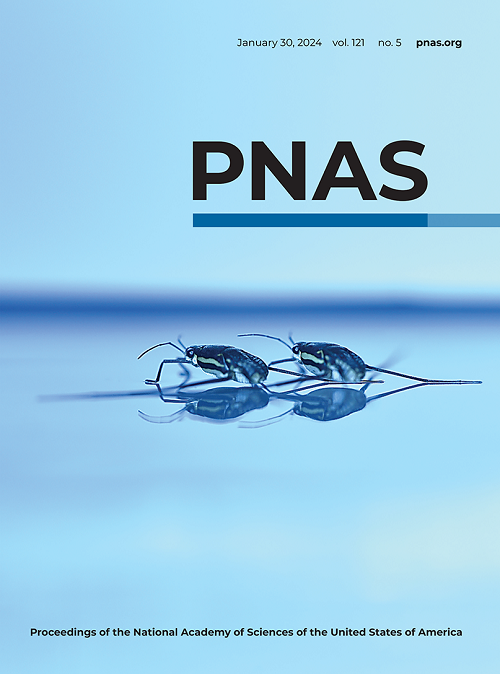多发性硬化症与肠道微生物群:来自多发性硬化症双胞胎回肠的钩端螺旋菌在无菌转基因小鼠中引发多发性硬化症样疾病--一项无偏见的功能研究
IF 9.1
1区 综合性期刊
Q1 MULTIDISCIPLINARY SCIENCES
Proceedings of the National Academy of Sciences of the United States of America
Pub Date : 2025-04-21
DOI:10.1073/pnas.2419689122
引用次数: 0
摘要
我们开发了一种双层策略,旨在确定与多发性硬化症(MS)发病有功能关联的肠道细菌。首先,我们比较了81对与多发性硬化症不一致的单卵双胞胎的肠道微生物特征。这种方法可以最大限度地减少遗传和早期环境因素的混杂影响,并鉴定出 50 多种不同的丰富类群,其中大多数增加的类群属于真菌纲。这些分类群包括以前描述过的与多发性硬化症相关的分类群(Anaerotruncus colihominis 和 Eisenbergiella tayi),以及新发现的分类群,如 Copromonas 和 Acutalibacter。其次,我们研究了个别类群的肠道生境和功能对类似 MS 疾病发展的影响。作为一种探索性方法,我们通过肠镜从所选孪生兄弟的不同肠道片段采集微生物群样本,并比较它们的组成特征。为了评估它们的功能潜力,我们将样本口服转移到无菌转基因小鼠体内,这种小鼠在细菌定植后容易自发发生类似 MS 的实验性自身免疫性脑脊髓炎(EAE)。我们发现,MS 衍生的回肠微生物群诱发 EAE 的比率大大高于来自健康双胞胎供体的类似物质。此外,雌性小鼠比雄性小鼠更容易发病。经鉴定,可能具有活性的微生物是塔伊艾森贝里菌(Eisenbergiella tayi)和拉克诺斯梭菌(Lachnoclostridium),它们都是拉克诺斯梭菌科(Lachnospiraceae)的成员。我们的研究结果确定了从受多发性硬化症影响的双胞胎回肠中取样的潜在致病细菌。这种实验策略可能会为从功能上理解肠道微生物群在多发性硬化症发病中的作用铺平道路。本文章由计算机程序翻译,如有差异,请以英文原文为准。
Multiple sclerosis and gut microbiota: Lachnospiraceae from the ileum of MS twins trigger MS-like disease in germfree transgenic mice—An unbiased functional study
We developed a two-tiered strategy aiming to identify gut bacteria functionally linked to the development of multiple sclerosis (MS). First, we compared gut microbial profiles in a cohort of 81 monozygotic twins discordant for MS. This approach allowed to minimize confounding effects by genetic and early environmental factors and identified over 50 differently abundant taxa with the majority of increased taxa within the Firmicutes . These included taxa previously described to be associated with MS ( Anaerotruncus colihominis and Eisenbergiella tayi ), along with newly identified taxa, such as Copromonas and Acutalibacter . Second, we interrogated the intestinal habitat and functional impact of individual taxa on the development of MS-like disease. In an exploratory approach, we enteroscopically sampled microbiota from different gut segments of selected twin pairs and compared their compositional profiles. To assess their functional potential, samples were orally transferred into germfree transgenic mice prone to develop spontaneous MS-like experimental autoimmune encephalomyelitis (EAE) upon bacterial colonization. We found that MS-derived ileal microbiota induced EAE at substantially higher rates than analogous material from healthy twin donors. Furthermore, female mice were more susceptible to disease development than males. The likely active organisms were identified as Eisenbergiella tayi and Lachnoclostridium, members of the Lachnospiraceae family. Our results identify potentially disease-facilitating bacteria sampled from the ileum of MS affected twins. The experimental strategy may pave the way to functionally understand the role of gut microbiota in initiation of MS.
求助全文
通过发布文献求助,成功后即可免费获取论文全文。
去求助
来源期刊
CiteScore
19.00
自引率
0.90%
发文量
3575
审稿时长
2.5 months
期刊介绍:
The Proceedings of the National Academy of Sciences (PNAS), a peer-reviewed journal of the National Academy of Sciences (NAS), serves as an authoritative source for high-impact, original research across the biological, physical, and social sciences. With a global scope, the journal welcomes submissions from researchers worldwide, making it an inclusive platform for advancing scientific knowledge.

 求助内容:
求助内容: 应助结果提醒方式:
应助结果提醒方式:


